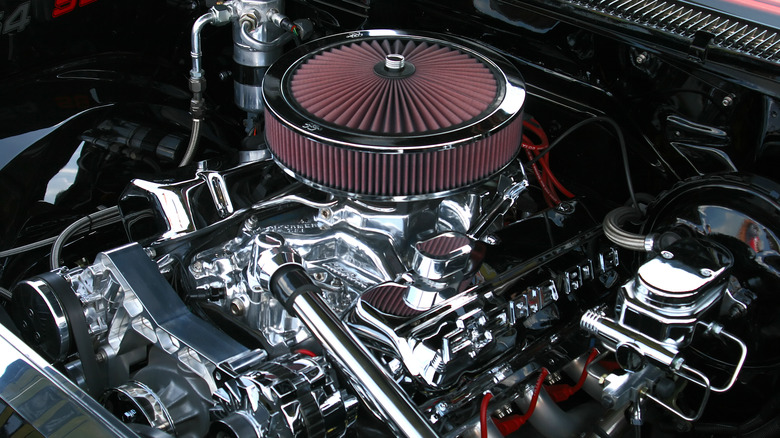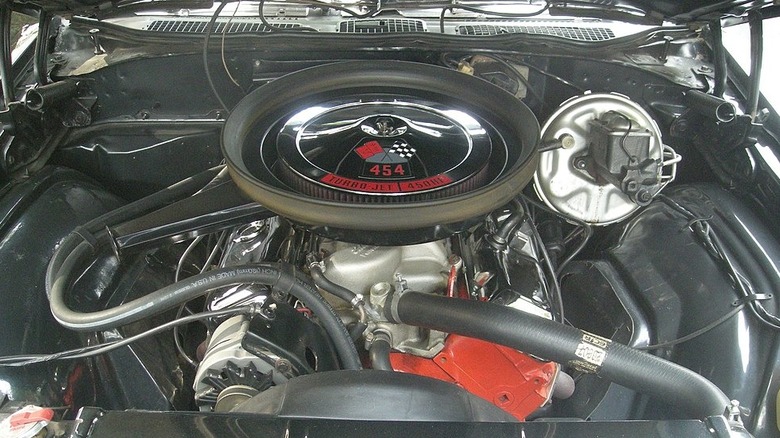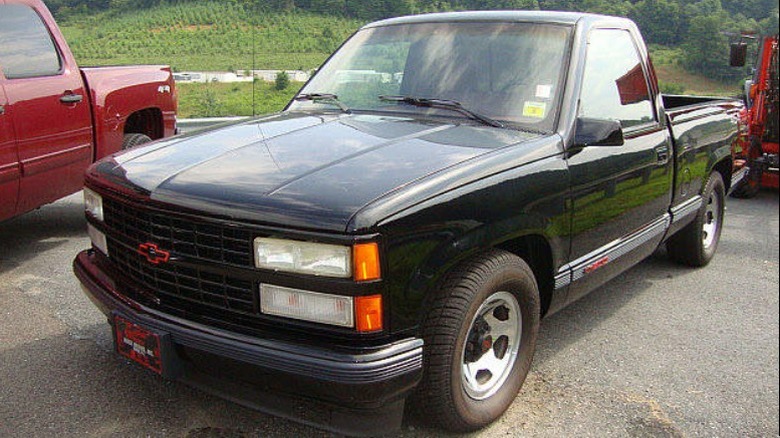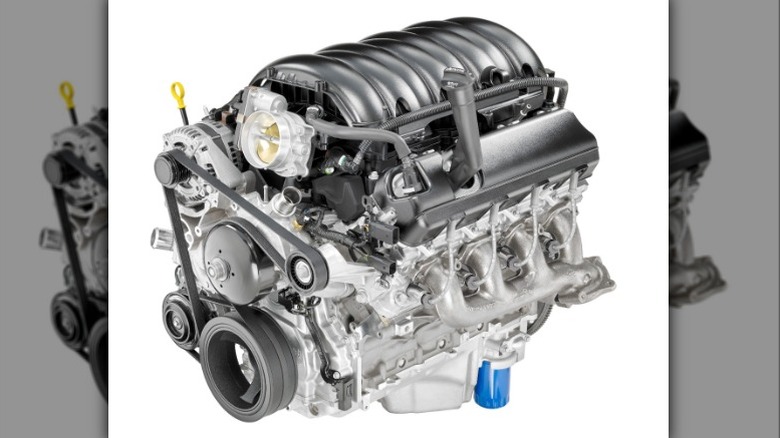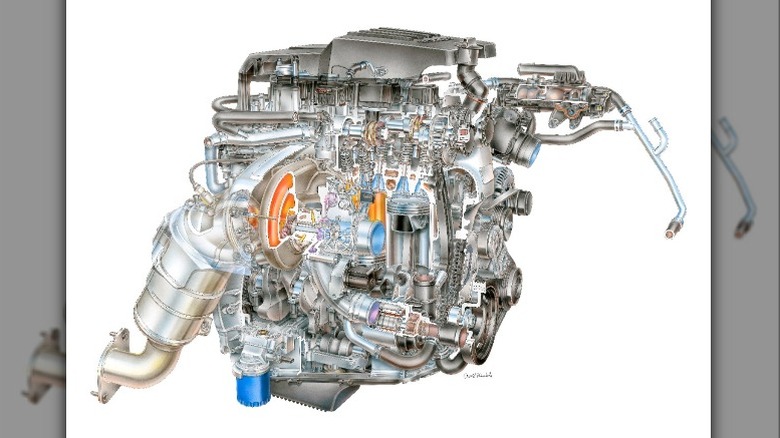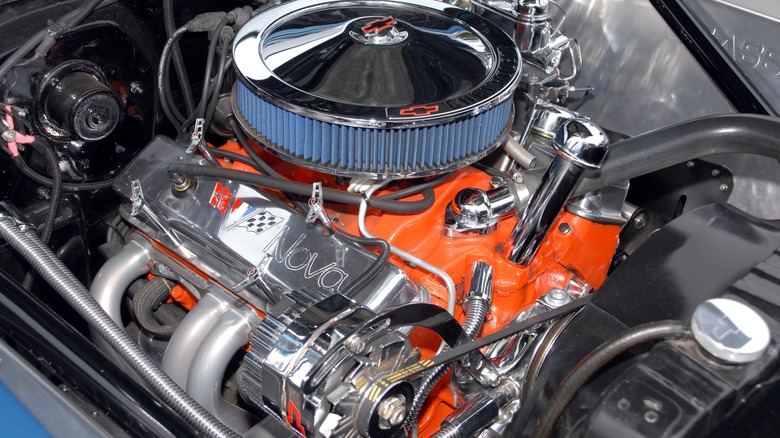5 Of The Best Engines Ever Put In A Chevy Truck
Once the sole domain of farmers and construction trades, pickup trucks have become increasingly popular as do-everything family transportation. For 2022, the top three selling vehicles in the United States of any type were the Ford F-150, Chevy Silverado, and Dodge Ram, respectively. As such, their once utilitarian engines, more concerned with torque and reliability, have gradually been replaced with increasingly performance-oriented options.
With many automakers focusing the majority of their resources on electrification, Chevrolet's parent company, General Motors, bucked that trend by announcing in January 2023 an $854 million investment into developing and building a new sixth-generation small block V8 engine. Much of the motivation for continuing the Chevy V8's lineage is the existence of trucks and SUVs, which have proven a challenge to electrify without hampering range while hauling and towing.
So, to botch a quote by Mark Twain, the death of the internal combustion engine has been greatly exaggerated. With that in mind, let's take a look at some of the best engines that ever graced a Chevy pickup truck. And surprise, there's even one non-V8 on the list.
1970 LS6 454 cubic-inch V8
Chevrolet's ground-pounding LS6 454 cubic-inch "big block" V8 was only available for two short years, and only one year in vehicles other than the Corvette. In 1970, buyers of the Chevelle and El Camino could opt for the 450-horsepower mill, which also cranked out an impressive 500 pound-feet of torque. Some enthusiasts feel that both of those numbers were deliberately underrated by Chevy to keep insurance companies from having a fit, especially if the engines were fitted with aftermarket tubular exhaust manifolds (a.k.a., "headers").
Some might argue that the El Camino is a utility coupe, not a true truck, but with a cargo bed more than six and a half feet long, longer than many modern crew-cab pickups, we're just fine doling out the truck designation. To order the LS6, El Camino buyers first had to opt for the Super Sport (SS) package, which included a special grill, bulged hood, upgraded wheels, suspension, and more.
The beastly LS6 454 could be backed by Chevy's heavy-duty Turbo-Hydramatic 3-speed automatic transmission or the equally hefty Muncie M22 4-speed manual, nicknamed the "rock crusher" because of the noise created when shifting due to its reduced gear angles. Reportedly, only 500 El Caminos were LS6 equipped, making this the rarest engine on this list.
[Featured image by Michael Barera via Wikimedia Commons | Cropped and scaled | CC BY-SA 4.0]
1990 - 1993 L19 454 SS
In 1990, Chevy reintroduced the big block 454 in a light-duty pickup, aptly named the 454 SS. In contrast to the fire-breathing LS6 from 1970, the 1990s L19 engine was downright tame, in spite of sharing the exact same displacement. The initial output was 230 horsepower and 385 lb-ft of torque, bumped to 255 horsepower and 405 lb-ft of torque for the 1991-1993 model years. At least the torque numbers were representative of the big blocks of yore.
So why include the 454 SS if it wasn't that impressive? It played a huge role in ushering in the modern muscle truck movement. Shortly after the sporty 454 SS dropped, Ford followed suit with its F-150 Lightning. See, before the Lightning name was reassigned to a popular all-electric truck, it was a performance-oriented creation from Ford's Special Vehicle Team, powered by a high-output 5.8-liter gasoline V8. Several years later, Dodge debuted its Ram SRT-10 and the rest is history.
Although its performance is lukewarm by modern standards, enthusiasts have the 454 SS and its L19 engine to thank for vehicles like today's F-150 Raptor and Ram TRX.
[Featured image by Angilas89 via Wikimedia Commons | Cropped and scaled | Public Domain]
2019 - Present L87 6.2-liter V8
Introduced for the 2019 model year trucks and SUVs, Chevy's L87 "EcoTec3" V8 was an immediate success, landing a place on Ward's 10 Best Engine list of 2019. The L87 is a worthy successor to the popular L86, itself a successor to the LT1 found in GM cars. Power output in a stout 420 horsepower and 460 lb-ft of torque, with an additional 15 horsepower available via Chevy's Performance Upgrade Package, which consists of a less restrictive exhaust system and a free flow air intake.
The big news on the L87 was GM's Dynamic Fuel Management which calculates how many of the engine's eight cylinders are necessary to provide adequate power for the current load and shuts down unneeded cylinders for improved fuel economy. With 17 different cylinder patterns, the EcoTec3 6.2-liter V8 can run on as few as two cylinders.
Fuel economy for a four-wheel drive Silverado half-ton truck is estimated at 16 mpg in the city and 21 mpg on the highway. While not exactly Prius-like specifications, it's brag-worthy for a 400+ horsepower truck that weighs over 5,100 pounds.
2019 - Present 2.7-liter turbocharged 4 cylinder
The march toward smaller displacement engines with forced induction is undeniable and Chevy's latest offering is one of the best examples of the breed. Shared with Chevy's midsize Colorado truck and less than half the size of other powerplants on this list, the 2.7-liter four-cylinder that's standard in new Silverado pickups cranks out 310 horsepower and 348 lb-ft of torque. That's 22% more torque than the naturally aspirated V6 that this motor replaced, plus the torque is available across a wider RPM range.
The obvious benefit of a four-cylinder is fuel economy and the little Chevy delivers to the tune of 19 mpg around town and 21 mpg on the highway. Over the course of a year, that represents several hundred dollars in fuel savings versus the optional 5.3-liter V8, as well as a cost savings of $1,500 to $2,000 when purchasing the vehicle. Strangely, the compact 2.7-liter four-cylinder has been said to sound like a clattering diesel engine, probably because of its dual-volute turbocharger, a design that was previously reserved for large commercial diesel powerplants.
1969 - 1995 first-gen 5.7-liter V8
Chevrolet's small-block V8, perhaps the most significant V8 engine ever designed, was introduced in 1955 to steal some thunder from Ford's recently introduced Y block. Starting out with a modest 265 cubic-inch displacement, engineers tweaked the bore and stroke until arriving at the ubiquitous 350 cubic-inch (5.7-liter) version in 1969. For the next three decades, the "350" powered just about everything Chevrolet manufactured from the Corvette to the compact Nova. And of course, it powered pickup trucks.
From 1969 up until 1995, the first-generation Chevy 350 powered three different generations of pickup trucks including the second-generation "Action Line", the third-generation "Square Body," and the fourth-generation "Original Body Style" (OBS).
During that time, minor updates were made such as High Energy Ignition (HEI), serpentine accessory drive, and throttle body fuel injection in the 1980s, but the overall architecture remained remarkably true to its 1950s roots. This motor is simple, reliable, and inexpensive to maintain, with unequaled support in the aftermarket parts arena, making it easy to hot rod if you want your truck to haul more than just cargo.
